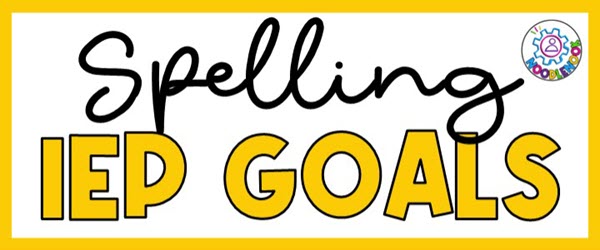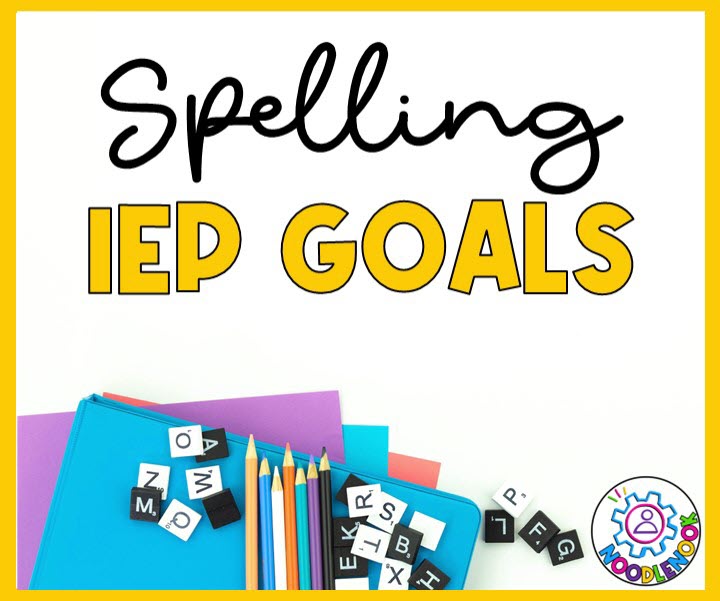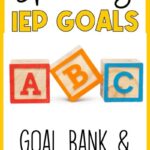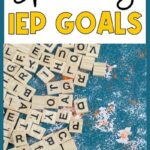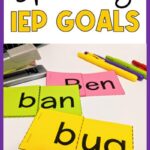Developing measurable goals for an effective Individualized Education Program (IEP) is vital for supporting the educational needs of special education students. When it comes to spelling IEP goals, setting clear and achievable objectives can significantly enhance a student’s language skills and overall academic success. In this blog post, we’ve got a comprehensive goal bank for spelling IEP goals. We also have some ideas on how to teach students with spelling goals to be better writers.
Why Spelling Specific Instructional Goals Matter
Spelling is an essential skill that plays a significant role in a student’s academic success. For special education teachers, it is crucial to set specific instructional goals to address individual students’ needs and support their progress. When crafting smart IEP goals, the IEP team should consider the student’s grade level, the given subject, and the intended outcome of instruction. Spelling may not be the ONLY focus for a student in writing. You want to focus on other necessary components and specific skills. That includes things like identifying main ideas, constructing topic sentences, and writing complete sentences. When instruction targets all of these skills, students can develop their writing abilities and express themselves more effectively.
Teacher Strategies for Spelling Interventions
Effective spelling interventions are crucial for supporting students’ spelling development and addressing their individual needs. Here are actionable strategies and interventions for teachers working with students in the classroom:
Assess and Track Progress:
- Administer regular spelling tests to evaluate students’ spelling proficiency.
- Focus on teaching and reinforcing CVC word (consonant-vowel-consonant) or CVCE word lists to build foundational spelling skills.
- Use writing samples and analyze students’ ability to construct a topic sentence and five-sentence paragraph s to identify areas for improvement.
- Align spelling IEP goals with the expression goals outlined in the child’s IEP, addressing their special needs and individualized learning goals.
Provide Explicit Instruction:
- Use a word list that includes essential spelling words, new words, and sight words relevant to students’ grade level.
- Teach short vowels and the correct order of letters in words to ensure accurate spelling.
- Incorporate a writing rubric to guide students in meeting spelling expectations and achieving smart goals.
- Develop effective IEP goals that focus on spelling accuracy, measured by the percentage of correct spellings in writing assignments.
Differentiate Instruction:
- Offer multiple-choice word options in spelling activities to support students with diverse learning needs.
- Tailor interventions based on sample IEP goals and individual student goals to address specific spelling challenges.
- Teach meaningful word parts, such as prefixes, suffixes, and root words, to improve spelling skills and expand vocabulary.
- Encourage students to use spell-check tools as a resource while also teaching them the importance of learning conventional spelling.
Utilize Engaging Strategies and Resources:
- Implement spelling activities that align with students’ education programs and target their specific spelling needs.
- Develop an objective way to assess progress through a weekly spelling list, allowing students to practice and demonstrate their spelling skills.
- Integrate spelling instruction with reading skills by emphasizing the relationship between sound-letter patterns and word recognition.
- Focus on CVCE (consonant-vowel-consonant-silent e) words as students advance, addressing more complex spelling patterns.
Support and Motivate Students:
- Provide high-interest visuals and engaging materials to capture students’ attention and facilitate understanding.
- Foster phonological awareness through activities that promote sound-letter relationships and help students recognize and spell words accurately.
- Build on students’ prior knowledge and connect spelling instruction to their existing understanding of words and language.
- Set achievable spelling IEP goals that allow for consecutive trials, monitoring progress, and celebrating successes along the way.
- Encourage the development of social skills through collaborative spelling activities and peer support.
We are always under the gun in our literacy blocks to get the most we can out of the time we have. In that limited time available, it is crucial for teachers to prioritize effective spelling interventions. By implementing these strategies and interventions informed by educational research and best practices, teachers can support students’ spelling development. That means we can better address individual student needs and promote overall academic success.
Spelling IEP Goal Bank
Here are several spelling IEP goals that align with best practices when it comes to the findings from the National Reading Panel. As you set out to improve spelling and writing skills for students with disabilities and IEP plans, consider adapting new goals from these categories.
Building Foundational Skills:
- Goal: The student will demonstrate phonemic awareness by correctly identifying the sounds of individual letters and letter combinations.
- Goal: Given a grade-level writing assignment, the student will spell simple words, including CVC (consonant-vowel-consonant) words, with 90% accuracy.
- Goal: The student will use their knowledge of syllable patterns to accurately spell multi-syllabic words in writing samples across different content areas.
- Goal: The student will demonstrate phonemic awareness by producing the correct sounds for individual letters and blends.
- Goal: The student will correctly identify and spell high-frequency sight words in written assignments across various subject areas.
- Goal: The student will apply knowledge of letter-sound correspondence to write words using inventive spelling.
Improving Spelling Strategies:
- Goal: The student will utilize spelling strategies, such as sounding out words, visualizing word patterns, and using mnemonic devices, to improve spelling accuracy in writing assignments.
- Goal: With the support of assistive technology like spell-check programs, the student will independently correct spelling errors in written work.
- Goal: The student will develop proofreading skills to identify and correct spelling errors in their writing samples with increasing independence.
Expanding Vocabulary and Word Choice:
- Goal: The student will use context clues to determine the correct spelling of unfamiliar words in writing assignments across various subjects.
- Goal: The student will actively engage in vocabulary development activities to expand their understanding of word meanings and improve their spelling skills.
- Goal: Given a specific content area, such as science or history, the student will correctly spell subject-specific vocabulary words in writing assignments.
Applying Spelling Rules and Conventions:
- Goal: The student will demonstrate an understanding of common spelling patterns and consistently apply them in written work across content areas.
- Goal: The student will accurately spell irregular words, such as those with long vowels or complex spelling patterns, in writing assignments.
- Goal: The student will use transition words and phrases appropriately in writing, demonstrating improved spelling skills and coherence.
- Goal: The student will demonstrate an understanding of spelling rules (e.g., doubling consonants before adding suffixes, changing ‘y’ to ‘i’ when adding a suffix) and consistently apply them in written work.
- Goal: The student will accurately spell irregular words (words that do not follow regular spelling patterns) in written assignments across various subject areas.
- Goal: The student will apply spelling rules and patterns to accurately spell words with common prefixes and suffixes in written work.
RECAP: Spelling IEP Goals
Crafting measurable spelling IEP goals is an important first step in supporting the educational progress of special education students. The goal bank provided in this blog post offers a range of objectives that address specific spelling skills, vocabulary development, and the application of spelling rules in writing assignments. It is crucial for IEP teams, special educators, and general education teachers to collaborate and track the student’s progress using objective data and assessment of work samples. By implementing effective strategies, providing systematic instruction, and utilizing appropriate assistive technology, we can facilitate the student’s spelling skills and promote their personal success across various academic content areas. Remember, each student is unique, and spelling IEP goals should be tailored to their specific needs and abilities.
FAQ: Spelling Instruction and Goals
Q: What are some effective strategies for teaching spelling to special education students?
A: There are several effective strategies for teaching spelling to special education students. Some strategies include providing explicit instruction, incorporating multisensory activities, using mnemonic devices, and offering differentiated instruction based on individual needs. It’s important to assess students’ spelling abilities, provide targeted interventions, and reinforce spelling skills through regular practice.
Q: How can I track and measure a student’s progress in spelling?
A: To track and measure a student’s progress in spelling, you can administer regular spelling tests, analyze writing samples, and use rubrics to assess spelling accuracy. You can also monitor the percentage of correctly spelled words in written assignments and track improvements over time. Taking data are essential skills for teachers. It supports their ability to set specific goals and document student progress that ensures effective spelling interventions are used.
Q: What are some effective ways to motivate students to improve their spelling skills?
A: Motivating students to improve their spelling skills can be achieved through various strategies. Providing high-interest materials and activities, incorporating games and interactive learning experiences, offering positive reinforcement and rewards, and fostering a supportive classroom environment can all contribute to motivating students to engage with spelling instruction and practice.
Q: How can technology assist in spelling interventions?
A: Technology can be a valuable tool in spelling interventions. Spell-check programs and assistive technology can help students identify and correct spelling errors independently. Additionally, there are various educational apps and online resources that provide interactive spelling activities and games to support students’ learning and engagement. If you have Google Classroom in your district, then you likely have access to Google ReadWrite from TextHelp. That will provide you with some predictive typing programs and is one of the best ways to get AT up and running in as little time as possible that actually helps students.
Q: How can I differentiate spelling instruction for students with diverse learning needs?
A: To differentiate spelling instruction for students with diverse learning needs, you can offer multiple-choice word options, provide visual and hands-on materials, tailor interventions based on individual goals, and incorporate meaningful word parts like prefixes and suffixes. It’s crucial to consider students’ strengths, challenges, and learning styles when planning and implementing differentiated spelling instruction.
Q: How can spelling instruction be integrated with other language skills?
A: Spelling instruction can be integrated with other language skills by emphasizing the relationship between sound-letter patterns and word recognition. Connecting spelling with reading skills, such as phonics and decoding, can help students understand how words are formed and improve their overall language proficiency. Additionally, incorporating vocabulary development activities can expand students’ word knowledge and enhance their spelling abilities.
Q: How can I effectively administer and utilize spelling tests in early elementary (ie: for second-grade students)?
A: When administering a spelling test for in early elementary, specifically for second-grade students there are a few steps you can follow. First, provide a list of age-appropriate words, including CVC words and CVCE words, to assess their spelling proficiency. Then, using task cards or interactive learning materials can make the testing process engaging. Evaluate their spelling accuracy by calculating the percentage of correctly spelled words. This data can help inform instruction and set spelling IEP goals based on their specific areas of need.
Q: What is the importance of teaching topic sentences and five-sentence paragraphs in spelling instruction?
A: Teaching topic sentences and five-sentence paragraph formats as part of your writing instruction is essential. It is how students learn to generate long-form content and use a consistent framework for sharing thoughts. By incorporating these concepts, students learn to organize their thoughts and express themselves more effectively. By teaching and reinforcing that framework early, even during spelling instruction, students can see how spelling accuracy contributes to overall written expression and aligns with their expression IEP goals.
Q: What can I do when a child struggles with spelling? Can I use spell-check programs?
A: Spell-check programs can be a valuable resource for students who struggle with spelling. By teaching students how to utilize spell-check effectively, they can independently correct spelling errors in their writing sample. However, it’s important to balance the use of spell-check programs with teaching the importance of learning conventional spelling rules and developing their knowledge of sound-letter relationships.
Q: How can I incorporate high-interest visuals and good educational practices into spelling instruction for second-grade students?
A: Incorporating a high-interest visual is an effective way to engage second-grade students in spelling instruction. Use colorful and meaningful images related to the words they are learning to enhance their understanding and retention. It aligns with good educational practice by promoting active learning and multisensory experiences that support vocabulary development and the recognition of vowel patterns.
Q: What are some evidence-based strategies supported by the National Reading Panel to improve spelling skills?
A: The National Reading Panel recognizes several evidence-based strategies to improve spelling skills. These include teaching phonics and phonemic awareness, providing explicit instruction on spelling rules and syllable types, and integrating spelling instruction with reading and writing activities. Utilizing best practices identified by the National Reading Panel can enhance spelling instruction and promote students’ overall language development.
Q: Are there any predictive typing programs available to support students with complex words and spelling challenges?
A: Yes, there are predictive typing programs available that can support students with complex words and spelling challenges. These programs use advanced algorithms to anticipate and suggest the correct word as students type, helping them overcome spelling difficulties. However, it’s important to strike a balance between using predictive typing programs as a support tool and actively teaching and reinforcing spelling skills.
Get More IEP Goal Ideas
If you need more IEP goal banks to reference as you work on your caseload, check out these other posts:
- How to Write an IEP Goal – 4 Essential Elements
- Special Education: IEP at a Glance Printable (Easy Prep)
- List of Student Strengths and Weaknesses for an IEP
- IEP Transition Goal Bank
- Reading Comprehension IEP Goals
- Written Expression IEP Goals: Writing Goals in Special Ed
- Phonemic Awareness IEP Goals
- IEP Goals for Anxiety (What, Why, and How To in Special Ed)
- IEP Goals and Objectives for ADHD Students (with Examples)
- Behavior IEP Goals

